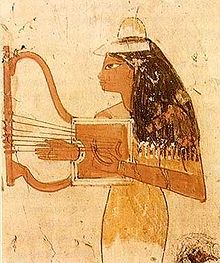Music of Egypt
Despite the lack of physical evidence in some cases, Egyptologists theorise that the development of certain instruments known of the Old Kingdom period, such as the end-blown flute, took place during this time.Egyptians in Medieval Cairo believed that music exercised "too powerful an effect upon the passions, and leading men into gaiety, dissipation and vice."[3]: 360–361 Male professional musicians during this period were called Alateeyeh (plural), or Alatee (singular), which means "a player upon an instrument".The typical line-up of trumpet, trombone, bass and snare drums, was popular, such as at family events, for well over a century, and is still played.Most of these stars, including Umm Kulthum, Abdel Halim, Fawzi and many others were part of the traditional Egyptian music.[7] Western classical music was introduced to Egypt, and, in the middle of the 18th century, instruments such as the piano and violin were gradually adopted by Egyptians.By the early 20th century, the first generation of Egyptian composers, including Yusef Greiss, Abu Bakr Khairat, and Hasan Rashid, began writing for Western instruments.In the early 21st century, even fourth generation composers such as Mohamed Abdelwahab Abdelfattah (of the Cairo Conservatory) have gained international attention.Religious music remains an essential part of traditional Sufi Muslim and Coptic Christian celebrations called mulids.Metqal Qenawi's Les Musiciens du Nil (Musicians of the Nile; who became known to Alain Weber in 1975), are the most popular Sa‘īdi group, and were chosen by the government to represent Egyptian folk music abroad.Hamza El Din was another popular Nubian Egyptian artist, well known on the world music scene and has collaborated with the Kronos Quartet.The Egyptian electronic music scene has gained a mainstream foothold in the forms of techno, trance, and dance pop DJs such as Aly & Fila.[10] In the 20th and early 21st centuries, interest in the music of the pharaonic/ancient Egyptian period began to grow, inspired by the research of such foreign-born musicologists as Hans Hickmann, who lived and worked in Egypt.





a seriesCultureArchitectureAncient Egyptian artContemporaryCinemaCuisineBelly danceRaqs sharqiBaladiTahtibTanouraFashionHistoryHolidaysLanguageLiteratureMythologySculptureAnthemTelevisionSocietyPeopleIdentityEducationDemographicsHealthHuman rightsReligionWildlifeWorld Heritage SitesPoliticsPresidencyGovernmentParliamentPolitical partiesMilitaryCorruptionLaw enforcementForeign relationsEconomyEnergyTourismTelecommunicationsTransportationEgyptian cultureEgyptianancient Greek musicEuropean musicEgyptian archaeologymaqamatiqa'atinstrumentalsEgyptiansHathorOsirisBastetancient Egyptprehistoric EgyptclappersOld Kingdomarched harpsflutesdouble clarinetsPercussion instrumentsMiddle KingdomCymbalsAncient Egyptianfolk musicclarinettisttrumpettrombonesnare drumsSayed DarwishUmm KulthumMohammed Abdel WahabAbdel Halim HafezBaligh HamdyAbdel HalimFatma SaidTeatro alla ScalaBBC Radio 3New Generation ArtistsCairo Opera HouseGiuseppe VerdiYusef GreissAbu Bakr KhairatHasan RashidGamal AbdelrahimRageh DaoudMohamed Abdelwahab AbdelfattahReligious musicSufi MuslimCoptic ChristianchurchMuslimAlexandrian RiteSufi dhikrmusic genreroots revivalfellahinSaii'daSiwa peopleEgyptian RomaniSinawisNubiansNasserpop musicsocialSherine Abdel-WahabMohamed MounirAmr Diabsimsimiyyadarbuka/tablaSuez Canalel-TanbouraUpper EgyptṢa‘īdiAlexandriaAli Hassan Kubanworld musicEgyptian ArabicNobiinHamza El DinKronos Quartetdarbuka
